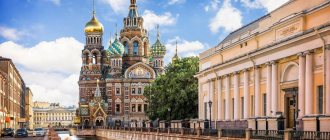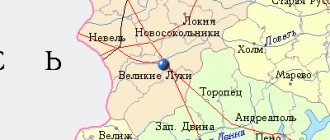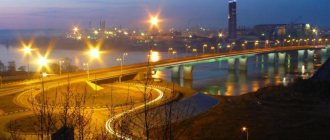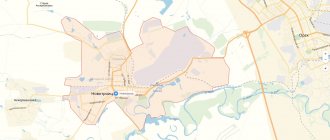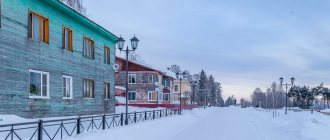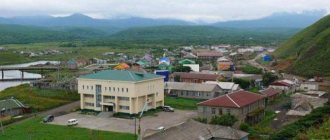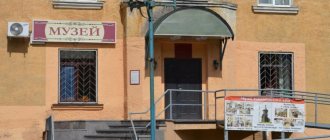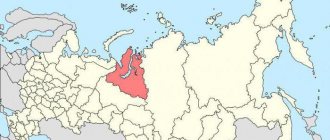This article is about the city district.
About the city, see Khimki. Khimki urban district
Khimki urban district
- a municipal formation (urban district) in the Moscow region, which includes a single populated area - the city of Khimki[3] and the adjacent territories.
It was formed in 2005 on the territory of the later abolished Khimki district
.
Story
The Khimki district of the Moscow region was formed in 1940[4]. The Khimki district includes the following administrative units:
- from the Krasnogorsk region: the city of Khimki; working settlements of Krasnooktyabrsky and Nikolsky; holiday village Novo-Khovrino; village councils Aksininsky, Businovsky, Kurkinsky, Novoluzhinsky, Petrovsko-Lobanovsky, Khimkinsky, Yurlovsky
- from Solnechnogorsk district: r.p. Kryukovo, Skhodnya; d.p. Firsanovka; s/s Alabushevsky, Andreevsky, Brekhovsky, Goretovsky, Kutuzovsky, Molzhaninovsky, Podolinsky, Rzhavsky, Uskovsky, Filinsky, Cherkizovsky, Chernogryazhsky.
On February 2, 1953, the city of Khimki received the status of a city of regional subordination.
On June 14, 1954, Brekhovsky, Businovsky, Goretovsky, Kurkinsky, Uskovsky, Filinsky, Khimkinsky, Cherkizovsky and Chernogryazhsky s/s were abolished.
On December 7, 1957, the city of Solnechnogorsk and the s/s Belavinsky, Berezhkovsky, Vertlinsky, Elizarovsky, Kirovsky, Kurilovsky, Litvinovsky, Moshnitsky, Obukhovsky, Peshkovsky, Povarovsky, Rakhmanovsky, Sokolovsky, Solnechnogorsky, Spas-Slobodsky and Tarakanovsky. December 19 r.p. Nikolsky was included within the city limits of Moscow.
On June 3, 1959, the city of Dolgoprudny was transferred from the abolished Krasnopolyansky district to Khimki; r.p. Beskudnikovo, Vagonoremont, Krasnaya Polyana, Lobnya, Nekrasovsky; d.p. Lianozovo, Lugovaya and Sheremetyevsky; s/s Belorastovsky, Bibirevsky, Verkhne-Likhoborsky, Vinogradovsky, Gabovsky, Kamensky, Kiovsky, Klyazminsky, Kotovsky, Krasnogorsky, Poyarkovsky, Sukharevsky, Fedoskinsky and Chashnikovsky. On July 31, the Litvinovsky s/s was abolished, and on August 29, the Kotovsky s/s.
On August 18, 1960, the Khimki district was abolished. At the same time, r.p. Beskudnikovo, Vagonoremont and Krasnooktyabrsky; d.p. Lianozovo and Novo-Khovrino; s/s Aksininsky, Bibirevsky, Verkhne-Likhoborsky, Novoluzhinsky and Petrovsko-Lobanovsky entered the city limits of Moscow (on the parts of the territory of Aksininsky and Novoluzhinsky s/s that were not included in the boundaries of Moscow, Starbeevsky and Rodionovsky s/s were formed). The city of Khimki and the villages of Klyazminsky, Molzhaninovsky, Rodionovsky and Starbeevsky entered the Krasnogorsk district. D.p. Sheremetyevsky and s/s Vinogradovsky, Krasnogorsky, Sukharevsky and Fedoskinsky entered the Mytishchi district. The rest of the Khimki district was transferred to the Solnechnogorsk district.
On January 11, 1965, the Khimki district was restored. It included the cities of Khimki and Skhodnya; r.p. Novopodrezkovo; d.p. Firsanovka; s/s Klyazminsky, Molzhaninovsky and Rodionovsky.
On September 17, 1974, the d.p. was formed. Starbeevo.
On October 29, 1984, due to the expansion of the Moscow city limits, Molzhaninovsky and Rodionovsky s/s were abolished.
On February 3, 1994, village councils were transformed into rural districts[5].
In 2004, by a series of decrees of the governor of the Moscow region (dated July 19[6], August 9[7] and September 15[8]), all settlements of the Khimki region were successively included in the city of Khimki (including the city of Skhodnya, which at that time time 19 thousand inhabitants).
In 2005, the municipal formation “Khimki District of the Moscow Region” was granted the status of an urban district[9]. Later, the Khimki district was abolished as an administrative unit.
The boundaries of the city district were slightly adjusted by separate regional laws in 2011[10] and 2012[2].
History of the city's development
The city got its name because it arose on the Khimka River (it no longer appears on maps - it was absorbed by the canal system) as a station village that appeared during the construction of a railway that connected the two Russian capitals in 1851.
By the middle of the 19th century, it was a popular dacha place around the villages: Kireevo, Kozmodemyanskoye, Krasnye Gorki, and later, the Tolstoulov wasteland was built up with dacha villages, and all these places were united and called Khimki.
Along with the industrial boom of the late 19th and early 20th centuries, serious enterprises came to Khimki: a dyeing plant, a cloth and wool-spinning factory, and thanks to the traffic flow from Moscow to St. Petersburg, the area developed rapidly.
Then the revolution broke out, and after it, furniture and knitting factories appeared, and construction of the Moscow-Volga canal (part of the Moscow Canal) began. The canal was built in 1932-1937, in 1937 Khimki was given the status of a workers' village, and two years later - a city.
County boundary
Khimki urban district borders
- with municipal districts of the Moscow region: Solnechnogorsk district,
- Krasnogorsk district,
- Mytishchi urban district,
Also, the Khimki urban district borders on the following administrative districts and districts of Moscow:
- Northern administrative district Levoberezhny district
- Molzhaninovsky district
- Khovrino
- Kurkino
- Savelki
The area of the territory of the Khimki urban district was, according to the laws of the Moscow region:
- dated February 22, 2005[9] - 11,020;
- dated June 24, 2011[10] - 10,997 hectares;
- dated April 27, 2012[2] - 10,979 hectares.
Transport
Important transport routes of Russia pass through the territory of the urban district: the M10
E 105
Moscow - St. Petersburg highway and the railway track of the Moscow branch of the Oktyabrskaya Railway with five stopping points:
- Levoberezhnaya platform
- Khimki station
- Podrezkovo platform
- Skhodnya station
- Firsanovka platform
Sheremetyevo International Airport is located on the territory of the Khimki urban district.
Property Features
Mass housing construction began in Khimki in the 1930s, when the village of Levoberezhny and the northern part of the future city were built, and in the following decades - the Dubki area near the canal.
Then the construction of residential buildings moved to the south, where the city center then moved (the so-called New Khimki). Subsequently, housing was built for workers in the aerospace industry, which the city specializes in to this day.
If you are interested in apartments in new buildings in Khimki, consider the advantages of this city.
Firstly, Khimki occupies a strategically advantageous position between Moscow and Sheremetyevo - it has transport accessibility, jobs, and an economically developed, and therefore socially prosperous, area.
Secondly, there is a favorable ecological situation, an abundance of natural resources (forests), proximity to “big water” (the water area of the Moscow Canal, the Khimki Reservoir, the Klyazma and Skhodnya rivers).
Notes
- ↑ 12
www.gks.ru/free_doc/doc_2016/bul_dr/mun_obr2016.rar Population of the Russian Federation by municipalities as of January 1, 2016 - ↑ 123
[mosobl.elcode.ru/page.aspx?106881 Law of the Moscow Region dated April 27, 2012 No. 42/2012-OZ “On Amendments to the Law of the Moscow Region “On the Status and Border of the Khimki Urban District””] - ↑ 12
[a[arhiv.inpravo.ru/texts3/document3570/index.htm Charter of the Khimki Urban District] - [w[www.admhimki.ru/histspr.html History of the district // Official website of the city district of Khimki]li>
- Handbook on the administrative-territorial division of the Moscow region 1929-2004. - M.: Kuchkovo pole, 2011. - 896 p. — 1500 copies. — ISBN 978-5-9950-0105-8.
- ↑ 12
[l[lawmix.ru/mskoblzk.php?id=11854 Resolution of the Governor of the Moscow Region No. 140-PG dated July 19, 2004 “On the unification of some settlements of the Khimki district of the Moscow region”] - ↑ 12
[l[lawmix.ru/mskoblzk.php?id=11493 Resolution of the Governor of the Moscow Region No. 163-PG dated August 9, 2004 “On the merger of some settlements with the city of Khimki, Moscow Region and the city of Skhodnya, Khimki District, Moscow Region”] - ↑ 12
[l[lawmix.ru/mskoblzk.php?id=10920 Resolution of the Governor of the Moscow Region No. 209-PG dated September 15, 2004 “On the unification of the city of Khimki, Moscow Region and the city of Skhodnya, Khimki District, Moscow Region”] - ↑ 12
[m[mosobl.elcode.ru/page.aspx?25148 Law of the Moscow Region No. 50/2005-OZ of February 22, 2005 “On the status and boundaries of the Khimki urban district”] - ↑ 12
[m[mosobl.elcode.ru/page.aspx?80660 Law of the Moscow Region No. 93/2011-OZ of June 24 “On Amendments to the Law of the Moscow Region “On the Status and Border of the Khimki Urban District” and the Law of the Moscow Region “On the Status and the border of the Dolgoprudny urban district"] - [demos[demoscope.ru/weekly/ssp/rus59_reg1.php All-Union Population Census of 1959] verified on October 10, 2013. [www.w[www.webcitation.org/6KGKkaTbE Archived from the original source on October 10, 2013]
- [demos[demoscope.ru/weekly/ssp/rus70_reg1.php All-Union Population Census of 1970. The current population of cities, urban-type settlements, districts and regional centers of the USSR according to the census data as of January 15, 1970 for republics, territories and regions] verified on October 14, 2013. [www.w[www.webcitation.org/6KMMUrFSL Archived from the original source 14 October 2013]
- demoscope.ru/weekly/ssp/rus79_reg1.php All-Union Population Census 1979
- [demos[demoscope.ru/weekly/ssp/rus89_reg1.php All-Union Population Census of 1989].w[www.webcitation.org/618gmeGGB Archived from the original on August 23, 2011]
- [www.p[www.perepis2002.ru/ct/doc/1_TOM_01_04.xls All-Russian population census 2002. Volume. 1, table 4. Population of Russia, federal districts, constituent entities of the Russian Federation, districts, urban settlements, rural settlements - regional centers and rural settlements with a population of 3 thousand or more].w[www.webcitation.org/65AdCU0q3 Archived from the original source February 3, 2012]
- ↑ 12
www.gks.ru/dbscripts/munst/munst46/DBInet.cgi?pl=8112027 Moscow region. Estimated resident population as of January 1, 2009-2016 - [www.g[www.gks.ru/bgd/regl/B09_109/IssWWW.exe/Stg/d01/tabl-21-09.xls Number of permanent population of the Russian Federation by cities, urban-type settlements and districts as of January 1, 2009 ]verified January 2, 2014. [www.w[www.webcitation.org/6MJmu0z1u Archived from the original on January 2, 2014]
- [www.g[www.gks.ru/free_doc/new_site/perepis2010/croc/Documents/Vol1/pub-01-11.xlsx Population Census 2010. Population of Russia, federal districts, constituent entities of the Russian Federation, urban districts, municipal areas , urban and rural settlements]s.). Federal State Statistics Service. Retrieved January 22, 2013. [www.w[www.webcitation.org/6GDBk0rPa Archived from the original on April 28, 2013]
- [www.g[www.gks.ru/free_doc/doc_2012/bul_dr/mun_obr2012.rar Population of the Russian Federation by municipalities. Table 35. Estimated resident population as of January 1, 2012] verified May 31, 2014. [www.w[www.webcitation.org/6PyOWbdMc Archived from the original May 31, 2014]
- [www.g[www.gks.ru/free_doc/doc_2013/bul_dr/mun_obr2013.rar Population of the Russian Federation by municipalities as of January 1, 2013. - M.: Federal State Statistics Service Rosstat, 2013. - 528 p. (Table 33. Population of urban districts, municipal districts, urban and rural settlements, urban settlements, rural settlements)] verified November 16, 2013. [www.w[www.webcitation.org/6LAdCWSxH Archived from the original November 16, 2013 ]
- [www.g[www.gks.ru/free_doc/doc_2014/bul_dr/mun_obr2014.rar Table 33. Population of the Russian Federation by municipalities as of January 1, 2014] verified on August 2, 2014. [www.w[www.webcitation. org/6RWqP50QK Archived from the original on August 2, 2014]
- [www.g[www.gks.ru/free_doc/doc_2015/bul_dr/mun_obr2015.rar Population of the Russian Federation by municipalities as of January 1, 2015] verified on August 6, 2015. [www.w[www.webcitation.org/6aaNzOlFO Archived from the original on August 6, 2015]
Map
Khimki: photo from space (Google Maps) Khimki: photo from space (Microsoft Virtual Earth)
| Khimki. Nearest cities. Distances in km. on the map (in brackets along roads) + direction. Using the hyperlink in the distance , you can get the route (information courtesy of the AutoTransInfo website) | |||
| 1 | Dolgoprudny | 5 (13) | NE |
| 2 | Krasnogorsk | 11 (12) | SW |
| 3 | Lobnya | 13 (23) | WITH |
| 4 | Nakhabino | 17 (24) | Z |
| 5 | Mytishchi | 17 (27) | IN |
| 6 | Moscow | 19 (21) | SE |
| 7 | Nekrasovsky | 20 () | WITH |
| 8 | Mendeleevo | 20 () | NW |
| 9 | Dedovsk | 20 (29) | Z |
| 10 | Andreevka | 21 (17) | NW |
| 11 | Novoivanovskoe | 22 () | YU |
| 12 | Korolev | 22 (33) | IN |
| 13 | Zarechye | 23 () | YU |
| 14 | Pavlovskaya Sloboda | 24 (32) | Z |
| 15 | Odintsovo | 27 (28) | YU |
| 16 | Pushkino | 28 (43) | NE |
| 17 | Zagoryansky | 29 () | IN |
| 18 | Vlasikha | 29 () | SW |
| 19 | Reutov | 29 (40) | SE |
| 20 | Povarovo | 30 () | NW |
| 21 | VNIISSOK | 31 () | SW |
| 22 | Ivanteevka | 31 (51) | IN |
| 23 | Pravdinsky | 31 (51) | NE |
| 24 | Lesnoy Gorodok | 32 (34) | SW |
| 25 | Balashikha | 33 (43) | IN |
| 26 | Gorki-10 | 34 () | SW |
| 27 | Shchelkovo | 34 (50) | IN |
| 28 | Forest | 35 (53) | NE |
| 29 | Istra | 36 (48) | Z |
| 30 | Fryazino | 37 (56) | IN |
a brief description of
The city is located on the banks of the Moscow Canal, adjacent to Moscow from the north-west, separated from it by the Moscow Ring Road (MKAD).
Territory (sq. km): 110
Information about the city of Khimki on the Russian Wikipedia site
Historical sketch
Originated on the river. Khimka (now on the site of its bed is the Moscow Canal) in 1850 as a station village on the St. Petersburg - Moscow railway. Khimki station was opened in 1851. Name after the river. Khimka, in the 16th-18th centuries. Khinka (from Baltic, Lithuanian kiminas "moss").
On the territory of modern Khimki, there were previously located the villages of Kurkino (until 1704 - the patriarch's village), Kozlovo, Kozmodemyanovskoye (at the end of the 16th century, the patrimony of Boris Godunov), Kireevo, the village of Krasnye Gorki, etc. Since the 1830s. The Khimki region has become a popular summer cottage destination. A.I. have been here Herzen, N.P. Ogarev, historians T.N. Granovsky, M.P. Pogodin; P.I. Tchaikovsky, I.I. Levitan, A.I. Kuprin, K.S. Stanislavsky and others.
At the end of the 19th century. To the north of the station, the holiday villages of Novy, Nikolaevsky, Petropavlovsky arose, which were later united into Khimki.
In the 19th - early 20th centuries. Industrial enterprises were built in Khimki and the surrounding area, incl. dyeing plant, cloth and wool spinning factories.
After construction in 1932-37. On the Moscow-Volga canal (now the Moscow Canal), a port was created in Khimki, and the village of Levoberezhny grew up on the left bank of the canal.
Since 1937, Khimki has been a working village, a city since March 26, 1939.
Municipal indicators
| Index | 1999 | 2001 | 2003 | 2005 |
| Demography | ||||
| Number of births, per 1000 population | 5.8 | 6.9 | 7.1 | 7.7 |
| Number of deaths, per 1000 population | 14.8 | 15.9 | 15.5 | 14.9 |
| Natural increase (decrease), per 1000 population | -9 | -9 | -8.4 | -7.2 |
| Standard of living of the population and social sphere | ||||
| Average monthly nominal accrued wages, rub. | 1922 | 5428 | 9495 | 15191 |
| Average housing area per inhabitant (at the end of the year), sq.m. | 24.7 | 27.6 | ||
| Number of preschool institutions, pcs. | 37 | 35 | 34 | 42 |
| Number of children in preschool institutions, thousand people | 4.5 | 4.5 | 4.5 | 5.5 |
| Enrollment of children in preschool educational institutions (at the end of the year), as a percentage of the number of children of the corresponding age, % | 72.3 | 67.3 | ||
| Number of daytime educational institutions (at the beginning of the school year), pcs. | 20 | 20 | 23 | 29 |
| Number of students in daytime educational institutions, thousand people | 16.6 | 15.4 | 13.7 | 15.5 |
| Number of doctors, people. | 391 | 362 | 413 | 421 |
| Number of nursing staff, people. | 677 | 602 | 666 | 704 |
| Number of hospital institutions, pcs. | 4 | 4 | 4 | 6 |
| Number of hospital beds, thousand units | 0.9 | 0.9 | 0.9 | 1.1 |
| Number of medical outpatient clinics, pcs. | 11 | 12 | 18 | 28 |
| Capacity of medical outpatient clinics, visits per shift, thousand units. | 3.9 | 3.9 | 4 | 5.4 |
| Number of registered crimes, pcs. | 1226 | 1641 | 1989 | 2978 |
| Persons who committed crimes were identified, persons. | 585 | 751 | 770 | 1083 |
| Economy, industry | ||||
| Number of enterprises and organizations (at the end of the year), pcs. | 3205 | 4442 | 4929 | 6782 |
| Number of operating enterprises by type of activity: mining (at the end of the year), pcs. | 0 | |||
| Number of operating enterprises by type of activity: manufacturing (at the end of the year), pcs. | 41 | |||
| Number of operating enterprises by type of activity production and distribution of electricity, gas and water (at the end of the year), pcs. | 16 | |||
| Volume of shipped goods of own production by type of mining (in actual prices), million rubles. | 0 | |||
| Volume of shipped goods of own production by type of manufacturing (in actual prices), million rubles. | 5784.6 | |||
| Volume of shipped goods of own production by type of production and distribution of electricity, gas and water (in actual current prices), million rubles. | 1737.5 | |||
| Construction | ||||
| Volume of work performed by type of activity “Construction” (until 2004 - volume of work performed under construction contracts), million rubles. | 384.3 | 471.2 | 1331 | 1131.2 |
| Commissioning of residential buildings, thousand sq.m. of total area | 62.5 | 55.6 | 115.3 | 129.8 |
| Commissioning of residential buildings, apartments | 862 | 826 | 1451 | 1656 |
| Commissioning of preschool institutions, places | 0 | 0 | 0 | 0 |
| Commissioning of educational institutions, places | 0 | 0 | 400 | 0 |
| Commissioning of hospital facilities, beds | 0 | 0 | 0 | 0 |
| Commissioning of outpatient clinics, visits per shift | 0 | 250 | 0 | 0 |
| Transport | ||||
| Number of bus routes (in intracity traffic), pcs. | 4 | 4 | 4 | 10 |
| Number of tram routes, pcs. | 0 | |||
| Number of trolleybus routes, pcs. | 2 | 2 | ||
| Length of operational trolleybus lines (at the end of the year), km | 8.5 | 8.5 | ||
| Number of passengers transported by buses per year (in intracity traffic), million people. | 19 | 21.5 | 9.3 | 12.4 |
| Number of passengers transported by trams per year, million people. | 0 | |||
| Number of passengers transported by trolleybuses per year, million people. | 9.7 | 13.5 | 16.8 | |
| Connection | ||||
| Number of residential telephone sets of the city public telephone network, thousand units. | 37.3 | 42.6 | 49.4 | 57.7 |
| Number of payphones of the city telephone network (including universal ones), pcs. | 283 | 325 | ||
| Trade and services to the population | ||||
| Retail trade turnover (in actual prices), million rubles. | 1287.4 | 4436.9 | 7198.3 | 15718.2 |
| Retail trade turnover (in actual prices), per capita, rub. | 9635.9 | 33013 | 50799 | 87383 |
| Index of physical volume of retail trade turnover, % compared to the previous year | 96.6 | 104.9 | ||
| Public catering turnover (in actual prices), million rubles. | 30.9 | 154.8 | 848.6 | 2407.8 |
| Index of physical volume of public catering turnover, % compared to the previous year | 233.3 | 86.9 | ||
| Number of stores, pavilions (at the end of the year), pcs. | 35 | 53 | ||
| Sales area of shops, pavilions (at the end of the year), sq.m. | 103137 | 125743 | ||
| Volume of paid services to the population (in actual prices), million rubles. | 427.5 | 698.9 | 1824 | 3540.6 |
| Volume of paid services to the population (in actual prices), per capita, rub. | 3200 | 5200.2 | 12873 | 19684 |
| Volume of household services to the population (in actual prices), million rubles. | 59.8 | 42.4 | 203.1 | 344.4 |
| Volume of household services to the population (in actual prices), per capita, rub. | 447.6 | 315.5 | 1434 | 1915 |
| Investments | ||||
| Investments in fixed assets (in actual prices), million rubles. | 308.6 | 1686.6 | 5697.3 | 8257.6 |
| Share of investments in fixed assets financed from budgetary funds in the total volume of investments, % | 8.6 | 3.9 | 1.4 | 3 |
Data sources:
- Regions of Russia. Main characteristics of the constituent entities of the Russian Federation: statistical collection. Goskomstat of Russia. - M:, 2002.
- Regions of Russia. Volume 1. Statistical collection. Goskomstat of Russia. - M:, 2001. p. 81
- Regions of Russia. Basic socio-economic indicators of cities. Statistical collection. Rosstat. - M:, 2005. p. 58
- Transport in Russia: Statistical collection. Goskomstat. - M:, 2003. pp. 112, 122
- Transport in Russia: Statistical collection. Rosstat. - M:, 2005. pp. 119, 129
- Regions of Russia. Basic socio-economic indicators of cities. 2006. Statistical collection. Rosstat. - M:, 2006. p. 58
Economy
NPO Energomash (production of rocket engines for launching scientific satellites), NPO for the production of wood panels, mechanized construction, production of tools and finishing machines.
, for the repair of commercial equipment, etc. Factory of plastic products. Light and food industry enterprises.
Art works factory.
Main enterprises
HEAVY, ENERGY AND TRANSPORT ENGINEERING
NPO im.
S.A. Lavochkina 141400, Moscow region, Khimki, Leningradskoye sh., 24
Offers:
rocket and space technology, electric lamps, chandeliers
NPO Power Engineering named after. Academician Glushko
141400, Moscow region, Khimki, st.
Burdenko, 1 Offers:
WOOD PROCESSING INDUSTRY
OJSC "Moscow experimental Skhodnenskaya factory of household furniture 'Skhodnyamebel'"
141420, Moscow region, Khimki, microdistrict.
Skhodnya, st. Nekrasova, 2 Offers:
upholstered and cabinet furniture, chipboard
ELECTRIC AND RADIO COMMUNICATIONS
JSC "Electrosvyaz"
141400, Moscow region, Khimki, st.
Proletarskaya, 23 Offers:
Culture, science, education
Moscow University of Culture (Levoberezhnaya platform), faculty of the Moscow Institute of Instrument Engineering.
Universities of the city
Academy of Civil Defense of the Ministry of Emergency Situations of Russia
141435, Moscow region, Khimki, Novogorsk microdistrict WWW: https://www.amchs.ru/
Institute of Business, Psychology and Management
141400, Moscow region, Khimki, st. Zoya Kosmodemyanskaya, 2 WWW: https://ibpu.ru/
Institute of International Economic Relations
141400, Moscow region, Khimki, Moskovskaya st., 38 WWW: https://www.imeo.ru/
Moscow State University of Culture and Arts (MGUKI)
141406, Moscow region, Khimki, st. Library, 7 WWW: https://www.mguki.ru/
Russian International Academy of Tourism
141420, Moscow region, Khimki, Skhodnya microdistrict, st. Oktyabrskaya, 10 WWW: https://www.rmat.ru/
Khimki branch of the Russian University of Cooperation
141400, Moscow region, Khimki, Oktyabrskaya st., 30
Museums, galleries, exhibition halls
Khimki Art Gallery named after. S.N. Gorshina 141400, Moscow region, Khimki, st. Moskovskaya, 15 Phone(s) Website: https://www.himkigalery.ru/
Architecture, sights
Vladimir Church (1678; on the territory of the former village of Kurkino), Church of Kosma and Damian (1730; on the territory of the former village of Kozmodemyanskoye). The main house of the former Patrikeev estate “White Pillars” (1905, architect F.I. Shekhtel; modern).
Since the 1930s The northern part of Khimki and the village of Levoberezhny were built up in the 1940-50s. Dubki area near the canal. In the 1970-80s. construction took place in the southern part of Khimki (the so-called New Khimki), where a new city center is being formed.
| Population by year (thousands of inhabitants) | |||||||
| 1926 | 2.9 | 1982 | 121 | 2005 | 179.7 | 2015 | 232.1 |
| 1939 | 23.1 | 1986 | 127 | 2006 | 180.1 | 2016 | 240.0 |
| 1959 | 47.8 | 1989 | 132.9 | 2007 | 181.0 | 2017 | 244.7 |
| 1962 | 51 | 1992 | 135.3 | 2008 | 183.6 | 2018 | 250.7 |
| 1967 | 70 | 1996 | 133.4 | 2010 | 188.5 | 2019 | 254.7 |
| 1970 | 86.6 | 1998 | 133.1 | 2011 | 207.4 | 2020 | 259.6 |
| 1973 | 94 | 2000 | 133.7 | 2012 | 215.5 | 2021 | 257.8 |
| 1976 | 103 | 2001 | 134.4 | 2013 | 221.1 | ||
| 1979 | 118.0 | 2003 | 141.0 | 2014 | 225.7 | ||
Links
Moscow region Urban districts Balashikha • Bronnitsy • Vlasikha (ZATO) • Voskhod (ZATO) • Dzerzhinsky • Dolgoprudny • Domodedovo • Dubna • Yegoryevsk • Zhukovsky • Zvenigorod • Star City (ZATO) • Ivanteevka • Kashira • Kolomna • Korolev • Kotelniki • Krasnoarmeysk • Krasnoznamensk (ZATO) • Lobnya • Losino-Petrovsky • Lytkarino • Molodezhny (ZATO) • Mytishchi • Ozyory • Orekhovo-Zuevo • Podolsk • Protvino • Pushchino • Reutov • Roshal • Serebryanye Prudy • Serpukhov • Fryazino • Khimki • Chernogolovka • Elektrogorsk • Elektrostal • Shakhovskaya
An excerpt characterizing the Khimki Urban District
“No, she doesn’t understand or is pretending,” thought Pierre. “It’s better not to tell her either.” The princess also prepared provisions for Pierre's journey. “How kind they all are,” thought Pierre, “that now, when they probably couldn’t be more interested in this, they are doing all this. And everything for me; That’s what’s amazing.” On the same day, the police chief came to Pierre with a proposal to send a trustee to the Faceted Chamber to receive the things that were now being distributed to the owners. “This one too,” thought Pierre, looking into the police chief’s face, “what a nice, handsome officer and how kind!” Now he deals with such trifles. They also say that he is not honest and takes advantage of him. What nonsense! But why shouldn’t he use it? That's how he was raised. And everyone does it. And such a pleasant, kind face, and smiles, looking at me.” Pierre went to dinner with Princess Marya. Driving through the streets between the burned-out houses, he was amazed at the beauty of these ruins. The chimneys of houses and fallen walls, picturesquely reminiscent of the Rhine and the Colosseum, stretched, hiding each other, along the burnt blocks. The cab drivers and riders we met, the carpenters who cut the log houses, the traders and shopkeepers, all with cheerful, beaming faces, looked at Pierre and said as if: “Ah, here he is! Let's see what comes out of this." Upon entering the house of Princess Marya, Pierre was filled with doubt as to the justice of the fact that he was here yesterday, saw Natasha and spoke with her. “Maybe I made it up. Maybe I’ll walk in and not see anyone.” But before he had time to enter the room, in his entire being, after the instant deprivation of his freedom, he felt her presence. She was wearing the same black dress with soft folds and the same hairstyle as yesterday, but she was completely different. If she had been like this yesterday when he entered the room, he could not have failed to recognize her for a moment. She was the same as he had known her almost as a child and then as the bride of Prince Andrei. A cheerful, questioning gleam shone in her eyes; there was a gentle and strangely playful expression on her face. Pierre had dinner and would have sat there all evening; but Princess Marya was going to the all-night vigil, and Pierre left with them. The next day Pierre arrived early, had dinner and sat there all evening. Despite the fact that Princess Marya and Natasha were obviously pleased with the guest; despite the fact that the whole interest of Pierre’s life was now concentrated in this house, by the evening they had talked everything over, and the conversation constantly moved from one insignificant subject to another and was often interrupted. Pierre stayed up so late that evening that Princess Marya and Natasha looked at each other, obviously waiting to see if he would leave soon. Pierre saw this and could not leave. He felt heavy and awkward, but he kept sitting because he couldn’t get up and leave. Princess Marya, not foreseeing an end to this, was the first to get up and, complaining of a migraine, began to say goodbye. – So you’re going to St. Petersburg tomorrow? – said oka. “No, I’m not going,” Pierre said hastily, with surprise and as if offended. - No, to St. Petersburg? Tomorrow; I just don't say goodbye. “I’ll come for the commissions,” he said, standing in front of Princess Marya, blushing and not leaving. Natasha gave him her hand and left. Princess Marya, on the contrary, instead of leaving, sank into a chair and looked sternly and carefully at Pierre with her radiant, deep gaze. The fatigue she had obviously shown before was now completely gone. She took a deep, long breath, as if preparing for a long conversation. All of Pierre's embarrassment and awkwardness, when Natasha was removed, instantly disappeared and was replaced by excited animation. He quickly moved the chair very close to Princess Marya. “Yes, that’s what I wanted to tell you,” he said, answering her glance as if in words. - Princess, help me. What should I do? Can I hope? Princess, my friend, listen to me. I know everything. I know I'm not worthy of her; I know it's impossible to talk about it now. But I want to be her brother. No, I don’t want to... I can’t... He stopped and rubbed his face and eyes with his hands. “Well, here,” he continued, apparently making an effort on himself to speak coherently. “I don’t know since when I love her.” But I have loved only her, only one, all my life and love her so much that I cannot imagine life without her. Now I don’t dare ask her hand; but the thought that maybe she could be mine and that I would miss this opportunity... opportunity... is terrible. Tell me, can I have hope? Tell me what should I do? “Dear princess,” he said, after being silent for a while and touching her hand, since she did not answer. “I’m thinking about what you told me,” answered Princess Marya. - I'll tell you what. You’re right, what should I tell her about love now... - The princess stopped. She wanted to say: it is now impossible to talk to her about love; but she stopped because for the third day she saw from Natasha’s sudden change that not only would Natasha not be offended if Pierre expressed his love to her, but that this was all she wanted. “It’s impossible to tell her now,” Princess Marya said. - But what should I do? “Entrust this to me,” said Princess Marya. “I know...” Pierre looked into Princess Marya’s eyes. “Well, well...” he said. “I know that she loves... will love you,” Princess Marya corrected herself. Before she had time to say these words, Pierre jumped up and, with a frightened face, grabbed Princess Marya by the hand. - Why do you think so? Do you think I can hope? You think?! “Yes, I think so,” said Princess Marya, smiling. - Write to your parents. And instruct me. I'll tell her when it's possible. I wish this. And my heart feels that this will happen. - No, this cannot be! How happy I am! But this cannot be... How happy I am! No, it can not be! - Pierre said, kissing the hands of Princess Marya. – You go to St. Petersburg; it is better. “And I’ll write to you,” she said. - To St. Petersburg? Drive? Okay, yes, let's go. But can I come to you tomorrow? The next day Pierre came to say goodbye. Natasha was less animated than in previous days; but on this day, sometimes looking into her eyes, Pierre felt that he was disappearing, that neither he nor she was any more, but there was only a feeling of happiness. “Really? No, it can’t be,” he said to himself with every look, gesture, and word that filled his soul with joy. When, saying goodbye to her, he took her thin, thin hand, he involuntarily held it in his a little longer. “Is this hand, this face, these eyes, all this alien treasure of feminine charm, will it all be forever mine, familiar, the same as I am for myself? No, this is impossible!..” “Goodbye, Count,” she told him loudly. “I’ll be waiting for you,” she added in a whisper. And these simple words, the look and facial expression that accompanied them, for two months formed the subject of Pierre’s inexhaustible memories, explanations and happy dreams. “I will be waiting for you very much... Yes, yes, as she said? Yes, I will be waiting for you very much. Oh, how happy I am! What is this, how happy I am!” - Pierre said to himself. Nothing now happened in Pierre's soul similar to what happened in it in similar circumstances during his matchmaking with Helen. He did not repeat, as then, with painful shame the words he had spoken, he did not say to himself: “Oh, why didn’t I say this, and why, why did I say “je vous aime” then?” [I love you, on the contrary, he repeated every word of hers, his own, in his imagination with all the details of her face, smile, and did not want to subtract or add anything: he only wanted to repeat. There was no longer even a shadow of doubt as to whether what he had undertaken was good or bad. Only one terrible doubt sometimes crossed his mind. Isn't this all in a dream? Was Princess Marya mistaken? Am I too proud and arrogant? I believe; and suddenly, as should happen, Princess Marya will tell her, and she will smile and answer: “How strange! He was probably mistaken. Doesn’t he know that he is a man, just a man, and I?.. I am completely different, higher.” Only this doubt often occurred to Pierre. He also didn’t make any plans now. The impending happiness seemed so incredible to him that as soon as it happened, nothing could happen. It was all over. A joyful, unexpected madness, of which Pierre considered himself incapable, took possession of him. The whole meaning of life, not for him alone, but for the whole world, seemed to him to lie only in his love and in the possibility of her love for him. Sometimes all the people seemed to him to be occupied with only one thing - his future happiness. It sometimes seemed to him that they were all as happy as he was, and were only trying to hide this joy, pretending to be busy with other interests. In every word and movement he saw hints of his happiness. He often surprised people who met him with his significant, happy looks and smiles that expressed secret agreement. But when he realized that people might not know about his happiness, he felt sorry for them with all his heart and felt a desire to somehow explain to them that everything they were doing was complete nonsense and trifles, not worth attention. When he was offered to serve or when they discussed some general, state affairs and war, assuming that the happiness of all people depended on this or that outcome of such and such an event, he listened with a meek, sympathetic smile and surprised the people who spoke to him with his strange remarks. But both those people who seemed to Pierre to understand the real meaning of life, that is, his feeling, and those unfortunate ones who obviously did not understand this - all people during this period of time seemed to him in such a bright light of the feeling shining in him that without the slightest effort, he immediately, meeting any person, saw in him everything that was good and worthy of love.
Khimki
Etymology
The city of Khimki near Moscow received its name from the river on which it was built. How the river got its name is not entirely clear. In ancient times, in different villages that stood on this river, it was called differently: Khynska, Khinska, Khimka, Khinka. The final form - Khimka - was established no more than two centuries ago. The name of the river can be associated with the word “khin”. This dialect word was used mainly in the Ryazan principality and meant “nonsense”, “nonsense”, “insignificant thing”. Consequently, Khimka is a small, insignificant river.
According to one of the folk tales, the river got its name after the daughter of a local rich man, Khimka, drowned in it. Whether it was an accident or suicide has not been established. There is also a Baltic version of the origin of this word. Middle Lithuanian himinas means "moss". The name is also associated with the name Efim (in common parlance – Fimka or Khimka). It is assumed that the original name was rethought under the influence of the word “chemistry” that came into use.
Kozmodemyanskoe village
The first mentions of Khimki date back to the 16th century. In documents of those years she is called differently: Khinka, Khilka, etc. However, we are undoubtedly talking about the same river. One of the most important land roads, connecting Moscow with Novgorod and Tver, passed through the river. The road passed near the village of Kozmodemyanskoye. The owners of the village were the boyars Kuchka and Chubarov. In 1585, the village became the patrimony of the future Tsar Boris Godunov. Many battles took place on the territory of the estate. In 1608-1609, a battle took place on these lands between Polish-Lithuanian invaders and Russian soldiers. The village was completely destroyed by the enemies. Kozmodemyanskoe was restored and for two centuries passed from one owner to another.
In 1812, the territory of the village again found itself in the combat zone. Residents of Kozmodemyansk and surrounding settlements actively participated in the fight against foreigners, joining the partisan movement.
The last owner of Kozmodemyansky was the merchant Patrikeev. He bought an estate that was burned down by peasants in 1905. A country mansion was built according to a new project. Soon the estate began to be called “White Pillars” thanks to the white columns located at the entrance to the estate. After the revolution of 1917, the mansion was taken away from Patrikeev and became public property. In 1918, a sanatorium for tuberculosis patients was organized in this mansion. The sanatorium was opened on the initiative of V.I. Lenin. One of the best doctors of that time, F. Getyev, who treated the leader of the proletariat himself, was transferred here. Soon Lenin visited the sanatorium again and was dissatisfied with its improvement. Repairs to the medical facility have not yet been carried out. There was no electricity in the building. Lenin demanded immediate repairs and electrification of the premises. The construction team leaders had to make a daily report on the work done. Vladimir Ilyich repeatedly visited the sanatorium not only to exercise control. He was attracted to hunting in these parts.
Settlements on the site of modern Khimki
Other settlements also became part of modern Khimki or the Khimki region. After the founding of St. Petersburg, the road called Tverskaya became known as the St. Petersburg tract. Several villages appeared along the tract: Kobylya Luzha, Black Mud, Butakovo and many others. It was decided to improve the quality of the road connecting St. Petersburg and Moscow. In 1722, the tract was reconstructed: a log flooring, made specifically for repair work, was covered with sand and clay. Reconstruction took 24 years. Despite the fact that so much time and effort was spent on reconstruction, the quality of the new road was not high. Empress Catherine II, who was passing through here, was dissatisfied with the newly repaired highway. Her carriage got stuck in the mud near one of the villages. The Empress had to wait a long time before the servants and local peasants finally pulled out the carriage. Having lost patience, Catherine called the village “a damned mare’s puddle.” So the village got a new name. Residents of Kobylya Luzha repeatedly turned to the empress with a request to rename the settlement. However, they failed to achieve the renaming. The village received its modern name only during the Soviet years. They called it New Puddle.
On the site of the current city of Khimki, 500 years ago there was the village of Kozlovo, surrounded by several small settlements, wastelands and abandoned villages. Local settlements received their names from the names of churches or from the names of their owners (Kirei Gorin, the Kozlov family). Villages and villages located on the territory of the Khimki region ( abolished in 2005
), were considered sufficiently populated. Each village had at least forty houses. Up to two hundred peasant families usually lived in the village. All buildings were wooden. The first stone building appeared in 1678. This building was the Vladimir Church, located in the village of Kurkino. Over the next centuries, several more churches were built on the territory of the future Khimki region. They were the only stone buildings.
Khimskaya station and station village
The city of Khimki itself began in the 19th century. In 1851, the Khimskaya station was opened (today it is called the Khimki station). The station belonged to the St. Petersburg-Moscow Railway. A station village arose not far from Khimskaya. Trains stopped at the station for no more than ten minutes. Khimskaya was the first station after Moscow. She was placed in fourth grade. There were the cashier, the station master with his assistant and the gendarme. A wooden platform, a station building, a hotel, a residential building for railway workers and some other outbuildings were built on Khimskaya. There was a buffet located in a tent not far from the station building. By the end of the 1860s, about forty people lived permanently at the station. These were mainly railway and station workers. The station was separated from the village of Kozmodemyanskoye by a ravine and a wooded wasteland.
The station village gradually grew and eventually merged with the village. The main street of Kozmodemyansky - Kuzminka - went around the ravine and stretched all the way to the station. At the beginning of the twentieth century, there were already about fifty households in the station village. A post office, a private pharmacy, a telegraph office, a tavern, 2 shops and a restaurant were built in the village.
The initiator of the construction of a railway that could connect Moscow with the new capital was Nicholas I. In 1838, traffic was officially opened in Russia along the country's first railway, called the Tsarskaya railway, which connected St. Petersburg with Pavlovsk. Then the need arose to connect St. Petersburg with Moscow by rail. In September 1841, Nicholas I received the project for the St. Petersburg-Moscow railway. The project was considered revolutionary for its time. The railway was supposed to use steam traction. Horse traction was several times more expensive and slower. Construction of the road began in 1843 and ended in 1851. The railway was of great national importance, as it connected the 2 main cities of the Russian Empire.
After serfdom was abolished, most of the landowners' estates in the vicinity of the Khimki station passed into the hands of the bourgeoisie and nobility. The new owners of the estates sought to benefit from their proximity to Moscow. The bourgeoisie began to rebuild its economy on a capitalist basis. Land began to be sold, and estates were rebuilt as country dachas. The lifestyle of the common people has also changed. Many began to rent out their houses for the summer to poor Muscovites who did not have the opportunity to rent a dacha from the “bourgeoisie.” Some peasants took up carting or selling agricultural products to visitors. There were also those who went to work on the railway or went to Moscow to earn money.
Khimki at the beginning of the 20th century
By the end of the 19th century, the first enterprises appeared on the territory of the future urban district of Khimki. Not far from the village of Yurovo there was a cloth factory, owned by Prince Menshikov. Then it passed to the merchant K. Ganke. Not far from the cloth production, a dyeing factory of the Giraud family was opened. The Izhisha cloth factory was built near the village of Gavrilovka. At the beginning of the twentieth century, A. Ivanov became the new owner of the factory. The company began to produce woolen fabrics. A wool spinning factory and a brick factory appeared not far from the village of Nikolskoye.
In 1917, after the victory of the revolution, numerous rallies were held in the Cherkizovskaya volost. The protesters demanded that the Provisional Government transfer the land to the peasants and immediately end the First World War. In each volost, volost self-government was created. Vocal deputies were elected to the volost assembly. Peasants who had reached the age of twenty were required to participate in the elections. The Cherkizovsk volost government was located in Skhodnya (now a microdistrict of the city of Khimki). Thus, the volost began to be called Skhodnenskaya. The revolution took place for the volost without any major shocks.
In 1918, a new volost was formed - Ulyanovskaya. Khimki becomes the administrative center of the volost. Ulyanovskaya included several more volosts: Durykinskaya, Cherkizovskaya, part of Vsekhsvyatskaya and Eremeevskaya. Until 1928, there were 4 settlements and 74 villages on the territory of the Ulyanovsk volost. The First World War and the Civil War, as well as the policy of war communism, caused enormous damage to the peasant economy of settlements in the area of the Khimki station. Military actions significantly slowed down the pace of development of the volost. Mortality increased sharply, caused by famine and numerous epidemics. Part of the male population of the volost did not return from the First World War. The village of Khimki in those years consisted mainly of one-story wooden houses. Apart from the Tsarskoye Highway, there were no streets paved with stone in the village. There was also no sewerage, running water or electricity. However, life in the volost gradually improved. Already in 1918, on the initiative of some railway workers, the first Soviet railway school was opened, located at the former dacha of the owner of the Presninskaya manufactory. The school could accommodate up to one hundred and fifty people at a time. The duration of schooling was 5 years.
Until the end of the 1920s, Khimki retained the character of a dacha area. In the early 20s, about two thousand people lived in the village. In 1926 the population grew to 2,876 people. The population growth is due to the fact that the station village merged with the dacha village of Petropavlovsky. A library, a fire brigade, an outpatient clinic, and a club appear in Khimki. In 1919, a first-level school was opened. The initiator of the opening was the former nobleman Vladimir Bolotov. At the end of the 20s, this educational institution was transformed into a school for peasant youth. The school was located where the park named after L.N. Tolstoy is located today. The director of the educational institution was Bolotov himself. He was also a teacher.
From the end of the 20s, the industrial growth of the station village began. A knitting artel appeared here, which over time turned into a knitted underwear factory. Due to the intensification of construction, the Nikolaev Brick Factory was forced to work year-round. Previously, it only worked seasonally. In the early 30s, the plant was reconstructed. During these same years, a furniture factory was built. A small artel for the production of mechanical products “Spartak” becomes a large enterprise. The settlement of the workers' artel was located on modern Spartakovskaya Street. New settlements appeared around Khimki: the villages of Mebelny, Pervomaisky, Central, Chkalovsky, Grabarovsky, Lobanovsky. In 1932, an aircraft repair plant was founded in Khimki. The first 2 multi-storey buildings were erected on Moskovskaya Street in the late 30s.
In the pre-war years, many new institutions were built in Khimki. In 1937, construction of the canal connecting the Volga and Moscow rivers was completed. The Northern River Port was created in Khimki. On the site of the village of Kireevo (the left bank of Khimki), a new village was built - Levoberezhny. Not far from the village, the dacha of the manufacturer Prokhorov has been preserved. The State Library Institute was transferred here in 1930 (today it is called the Moscow State University of Culture and Art), founded by N. Krupskaya. Since the canal cut off the station from the village, N. Krupskaya took the initiative to build the Levoberezhnaya platform.
Khimki became a city at the end of March 1939 as part of the working villages of Lobanovo, Khimki, Petrovskoye and two dacha villages - Nikolaevsky and Petropavlovsky. In 1940, Khimki became the administrative center of the newly formed Khimki district.
During the Great Patriotic War
Khimki became the closest settlement to the capital that the Nazis managed to reach during the Great Patriotic War. There is a legend that in mid-October 1941, a detachment of motorcyclists unexpectedly approached the city and seized the Leningradskoye Shosse bridge. The detachment, however, was destroyed. There is conflicting information about exactly where this happened. According to the research of historian A. Khorkov, German motor reconnaissance actually approached the bridge. But there was no fight. After examining the area, the Nazis left. According to another version, on October 16, a militia of students, women and teenagers was assembled in Khimki. It was this group that intelligence met. The Germans broke the resistance and reached Sokol. They still did not dare to enter the city. The scouts then returned to the bridge, where they took up a defensive position, awaiting reinforcements.
By decision of the State Defense Committee, they began to hastily build an “Additional defensive line” in Khimki. At the end of 1941, the aircraft repair plant was evacuated to Tashkent.
In 1945, electrification of government buildings and private farmsteads began in war-stricken villages. Bus service between all settlements in the region, Khimki and Moscow has been resumed. One of the first railways in the Soviet Union was Oktyabrskaya. The first years of peaceful life were marked by cultural, economic, household and railway construction.
Rocket Science Center
In the post-war years, Khimki became one of the most important centers of Soviet rocket science. The city housed the main enterprises of several scientific and production associations of the USSR, which had defense significance. Design Bureau Energomash, which was among these enterprises, provided development of engines for intercontinental ballistic missiles. IKB Fakel was developing anti-aircraft missiles. The Lavochkin NPO was engaged in the development of air-to-ground and surface-to-air missiles, as well as wide-spectrum spacecraft, cruise missiles and lunar rovers.
City streets
Khimki developed not only in the direction of rocket science. One of the areas of development was logging. In the 50s and 60s, a square was formed in front of the city administration building in Khimki. During those same years, many new streets appeared in the city due to intensive construction. Zheleznodorozhnaya Street runs parallel to the railway track. Aptechnaya Street appeared, connecting the first pharmacy and the station. Skoroprogonnaya Street, which ran among the barracks of Old Khimki, was renamed Pobeda Street in 1945. Many new streets were named after heroes of the Great Patriotic War, for example, Kudryavtsev Street, which was named in honor of Guard Lieutenant N. Kudryavtsev, who died in 1943 and destroyed 15 enemy tanks in one battle. One of the streets is named after the pilot M. Rodionov. The title of Hero of the Soviet Union was awarded to Rodionov only in 1948. The residents of Khimki did not forget to immortalize in the street names the names of those who were involved in the improvement of their hometown. The streets of M. Rubtsova and I. Melnikov bear the names of honorary citizens of the city who made a huge contribution to the development of Khimki. From the village of Nagornoye there is a highway named after the village of Nagornoye. In the 70s, a nine-story library building was built in the Levoberezhny microdistrict.
Modern period
In the mid-80s, a significant part of the territory of the Khimki region was assigned to Moscow. As a result, the area was divided into two parts. At the end of the 90s, a trolleybus was launched in Khimki, connecting 2 parts of the city. The trolleybus follows Yubileiny Avenue, Mayakovsky Street and Mira Avenue. By the end of the last century, 2 cinemas, 3 stadiums, many shops, secondary schools, the Rodina Palace of Culture, an art school, a technical school and a university of culture appeared here. In 1999, a McDonald's cafe was opened in the city.
The annexation of part of the Khimki district to the territory of Moscow was due to the fact that at the turn of the 20th-21st centuries there were no free and suitable areas for construction left in the capital. A huge number of offices of commercial companies and enterprises were demolished in the Moscow region. In the early 2000s, Khimki, along with other Moscow suburbs, became an area of mass residential development. One of the by-products of this solution to the problem was a transport collapse on the Leningradskoe Highway, which connects Khimki and the capital. In 2004, some settlements of the Khimki region were united with each other. Thus, the village of Uskovo and the village of Firsanovka were merged with the city of Skhodnya; the village of Vashutino and the holiday village of Starbeevo became part of Khimki. A decision on whether Khimki will be part of Moscow has not yet been made.
In recent years, Khimki has gained fame thanks to the movement to preserve the Khimki Forest. Several conflicts occurred during the movement and were widely reported in the media. In 2010, a group of young people protesting against deforestation vandalized the city hall building.
